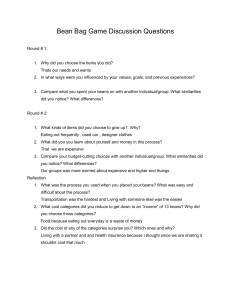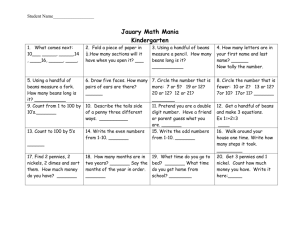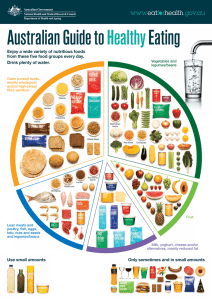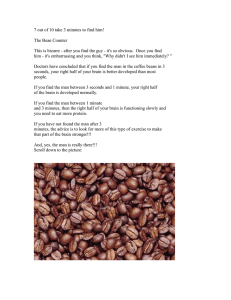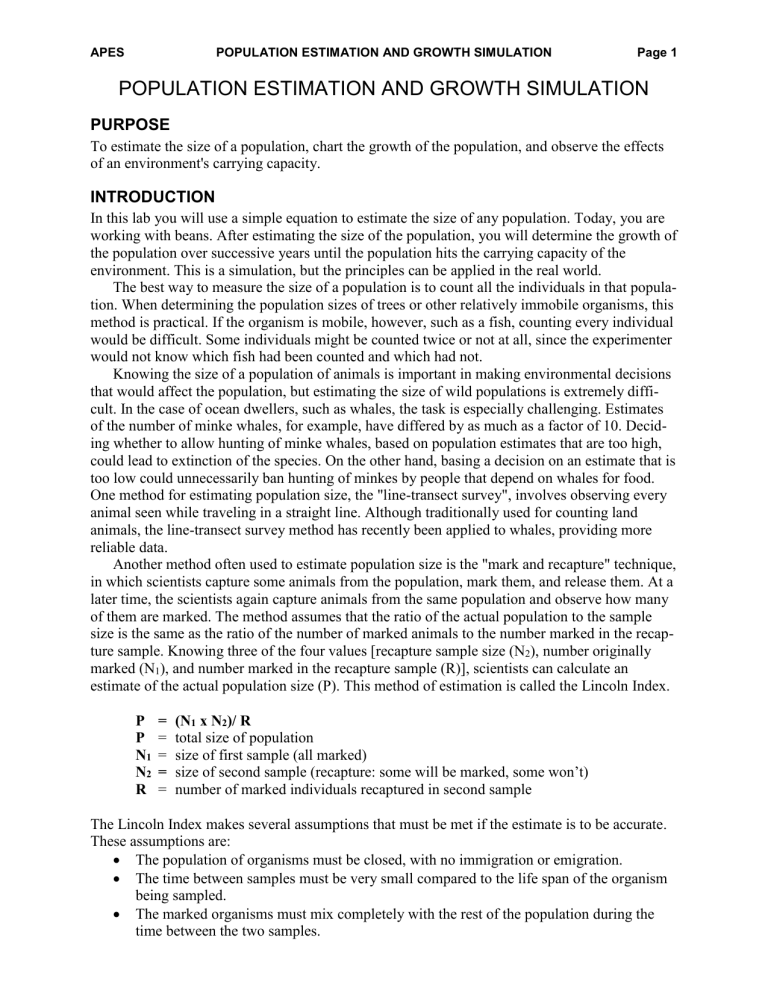
APES POPULATION ESTIMATION AND GROWTH SIMULATION Page 1
POPULATION ESTIMATION AND GROWTH SIMULATION
PURPOSE
To estimate the size of a population, chart the growth of the population, and observe the effects of an environment's carrying capacity.
INTRODUCTION
In this lab you will use a simple equation to estimate the size of any population. Today, you are working with beans. After estimating the size of the population, you will determine the growth of the population over successive years until the population hits the carrying capacity of the environment. This is a simulation, but the principles can be applied in the real world.
The best way to measure the size of a population is to count all the individuals in that population. When determining the population sizes of trees or other relatively immobile organisms, this method is practical. If the organism is mobile, however, such as a fish, counting every individual would be difficult. Some individuals might be counted twice or not at all, since the experimenter would not know which fish had been counted and which had not.
Knowing the size of a population of animals is important in making environmental decisions that would affect the population, but estimating the size of wild populations is extremely difficult. In the case of ocean dwellers, such as whales, the task is especially challenging. Estimates of the number of minke whales, for example, have differed by as much as a factor of 10. Deciding whether to allow hunting of minke whales, based on population estimates that are too high, could lead to extinction of the species. On the other hand, basing a decision on an estimate that is too low could unnecessarily ban hunting of minkes by people that depend on whales for food.
One method for estimating population size, the "line-transect survey", involves observing every animal seen while traveling in a straight line. Although traditionally used for counting land animals, the line-transect survey method has recently been applied to whales, providing more reliable data.
Another method often used to estimate population size is the "mark and recapture" technique, in which scientists capture some animals from the population, mark them, and release them. At a later time, the scientists again capture animals from the same population and observe how many of them are marked. The method assumes that the ratio of the actual population to the sample size is the same as the ratio of the number of marked animals to the number marked in the recapture sample. Knowing three of the four values [recapture sample size (N
2
), number originally marked (N
1
), and number marked in the recapture sample (R)], scientists can calculate an estimate of the actual population size (P). This method of estimation is called the Lincoln Index.
P = (N
1
x N
2
)/ R
P = total size of population
N
1
= size of first sample (all marked)
N
2
= size of second sample (recapture: some will be marked, some won’t)
R = number of marked individuals recaptured in second sample
The Lincoln Index makes several assumptions that must be met if the estimate is to be accurate.
These assumptions are:
The population of organisms must be closed, with no immigration or emigration.
The time between samples must be very small compared to the life span of the organism being sampled.
The marked organisms must mix completely with the rest of the population during the time between the two samples.
APES
MATERIALS
1 Lunch Bag
POPULATION ESTIMATION AND GROWTH SIMULATION
Beans
Pencil/Pen
Graph Paper (your own or get a sheet in class)
Calculator
Page 2
PROCEDURE
1) The teacher will provide you with a bag filled with beans.
2) Remove a small handful of beans from the bag.
3) Count the beans and record these beans in Table I under '# white beans replaced (marked) in
1 st
sample N
1
."
4) Replace the marked white with black beans and place the marked beans back into the bag.
5) Carefully and gently mix up the beans in the bag.
6) Remove a small handful of beans from the bag once again.
7) Count the total number of beans that you removed the second time and record this in Table I under "# in recapture sample N
2
."
8) Count the number of beans that are black and record the number of marked beans
# of black
(marked) beans in sample R
."
9) Calculate the estimated population after taking just one sample and record in the column P.
Using the following equation:
Calculated Total Population = (N
1
x N
2
)/ R = (Marked initially X Total sample size)
Total # of marked beans
10) Repeat taking samples this until you have a total of 10 samples collected and recorded.
11) Calculate your population estimate after all ten samples using the equation above.
12) Record the Calculated Total Population in Table I and II.
13) Carefully empty the bag of beans on the table (don't lose any!) and count the Actual Total
Population of Beans and record in Table II.
14) Calculate your percent error by using this equation:
Percent Error = (Actual Total Population - Calculated Total Population) X 100
Actual Total Population
This value is an absolute value (there cannot be a negative number). Record this in Table II under Percent Error.
15) Using your Calculated Total Population, the given birth rate, death rate and the change in population equation to calculate the growth or decline of the population over 15 years.
Here's some information that you need:
The birth rate (BR) of the beans per 100 beans per year is 50.
The death rate (DR) of the beans per 100 beans per year is 30.
The change in bean population (CP) is equal to BR - DR.
The way that you can calculate the new bean population year after year is by using the following equation:
The New Population # = (CP X Current Population) + Current Population
100
APES POPULATION ESTIMATION AND GROWTH SIMULATION Page 3
For example, if the current population is 200, and if you use the birth and death rate from above, then the equation would look like this:
The New Population # = (50-30) X 200 + 200 = 240
100
After 1 year the population went from 200 to 280 beans. Now here's the catch: the environment has only enough resources to sustain 600 beans. If the population of beans exceeds 600 beans, then you will switch the birth rate and death rate. In other words, the BR will equal 30 and the DR will equal 50.
16) Graph the results (Table III on next page). When graphing the information, make a straight line across the graph (parallel to the X axis) at the 600 bean level.
17) Answer the questions.
CONCLUSION
1) Was your population estimate accurate? Was your estimate after one sample or after 10 samples more accurate? What could lead to inaccuracies of this estimation technique?
2) How could you use this technique to estimate the population of grasshoppers in my backyard?
3) What will happen to the birth and death rates of a population if there aren't enough resources for all organisms? Why? (You may want to use the terms competition, predation).
4) In your own words, define Carrying Capacity and where is it on your graph.
5) What will eventually happen to the population size in reference to the carrying capacity of the environment?
6) Can we use a similar model for studying humans? Why or why not?
DATA TABLE I
Trial
#
1
# white beans replaced
(marked) in 1 st sample
N
1
2
3
4
5
6
7
8
9
10
# in recapture sample
N
2
Total
# of black
(marked) beans in sample
R
Estimated population
P
APES POPULATION ESTIMATION AND GROWTH SIMULATION
Lab Report:
Title Page
Data Table I
Data Table II
Data Table III
Conclusion Questions (1-6)
Plot of Table III
Table II. Population Estimation Data
Category
Calculated Total Population (after 1 sample)
Calculated Total Population (after 10 samples)
Actual Population Total
Percent Error
Data
7
8
9
10
11
12
13
14
15
2
3
4
5
6
Table III. Population Growth Data
Year Population in Beans
0 (record your calculated total pop.)
1
Page 4
